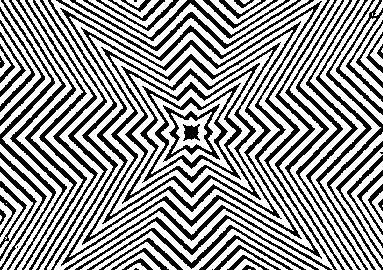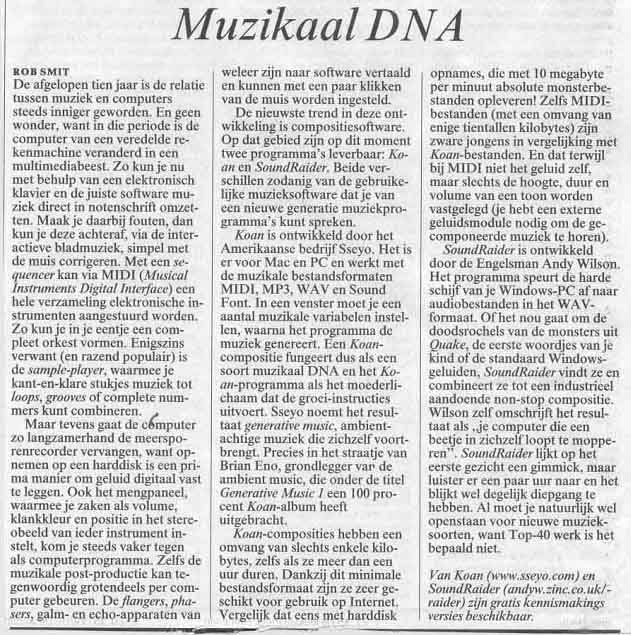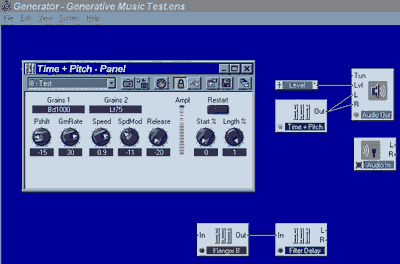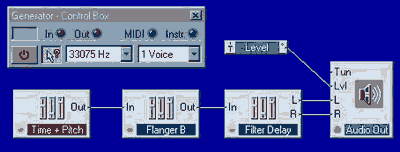
PSYCHEDELIC MUSIC - adapted from www.acidmagic.com
Psychedelic
is defined as: of, producing, or marked by abnormal psychic effects, such as
hallucinations and/or perceptual distortions, where the word psychic relates to
the psyche, or the soul, spirit and mind ...
It is believed that unusual psychic experiences may be caused by
non-physical, supernatural phenomena. Phenomena that cannot be explained by
known natural laws. These experiences are often regarded as communication with
the "spirit world".
Music is considered the art of organizing tones, in
combinations and sequences, into a continuous composition. Music is typically
characterized as having tempo, melody, rhythm and harmony.
The
combination of these words, psychedelic music, inspires visions of melody,
rhythm and harmony with psychic properties—properties unexplained by known
natural laws—supernatural properties, affecting the soul, spirit and mind.

Keep staring :-) This was a Mononom flyer (1996)
History
For time
immemorial, Native American Indians have used psychedelics, dance and hypnotic,
trance-inducing music as a gateway to the nether world. Psychedelic rituals
inspired dream-like visions and these brought insight into the harmony between
man and nature. Similar metaphors exist in cultures throughout the world.
It is believed that modern psychedelic music originated in 1961 when a
famous gram of LSD (known as "Lot No. H-00047") found its way to celebrities
such as Donavan, Paul McCartney, Keith Richard and Timothy Leary (to name only a
few, and dates are vague for McCartney and Keith Richard). Whether any music
resulted is unknown. It is certain, however, that this one event kicked off a
wave of international interest that remains today.
By 1962 psychedelic
usage had increased significantly and folk musicians were using LSD regularly to
get what they called "cerebrally electrified". The Gamblers, incidentally,
recorded the first song known about LSD in 1962.
The Monterey,
California Pop Festival of 1963 played a key role in the evolution of
psychedelic music—many there took LSD to celebrate and enhance their
appreciation of the festival. Musicians and artists soon began wide-scale
experimentation with ways to perform that would complement, direct and heighten
psychedelic effects or present a "flash" of the experience for the uninitiated.
By 1966, Haight-Ashbury was alive with psychedelic music furnished by
LSD-using groups such as Jefferson Airplane, the Grateful Dead, Big Brother and
the Holding Company and Country Joe and the Fish. Interestingly, they say that
the "Bay Area" style of music and dancing, if anything, emulated the tribal
American Indian. The psychedelic "wave" crested in 1967 when hundreds of
thousands of people (wearing all colors of the rainbow and with "flowers in
their hair") converged on San Francisco for "the summer of love".
Psychedelic festivals (or "Be-ins") played an important role in the
"flower-child" movement. Be-ins emphasized open, large-scale, uncontrolled
enjoyment of expanded consciousness. This large-scale unity reflected the
massiveness of the movement and consequently, the general public became
frightened. Furthermore, the movement, while peaceful, was antiestablishment in
that it opposed the Vietnam War. Hysteria ended in late 1967 when the US
government intervened—use of LSD and other psychedelic drugs became a felony
offense and be-ins were history.
Psychedelic music remained dormant for
almost 20 years, with the notable exception of the Grateful Dead. For over three
decades (until the recent death of Jerry Garcia), Dead shows provided a
year-round 60s be-in haven for the psychedelic community. During the 70s-80s-90s
hundreds of thousands people spent part of their life on the road, "touring"
with the Dead. The Grateful Dead were unique in that they continued the (the now
highly illegal) Haight-Ashbury tradition of experimenting with ways to direct
and heighten psychedelic effects during their shows.
"Acid house" and "tekno music" are the latest incarnation of psychedelic music. Raves are huge, all
night or weekend long dance parties fueled by MDMA, LSD, intense psychedelic
light shows and the trance inducing rhythms. The rave scene hit to
the US in the early 90s and has spread through most of Europe and parts of
Asia.
"Street Raves" are the latest "Be-in" phenomenon.
The Mystical Experience
Psychedelics are often related to the mystical experience and many
believe that what is witnessed during this altered state is not hallucination,
but what is considered "ultimate reality".
It is believed that the
mystical experience stems from direct communication with "God" or with "ultimate
reality". This typically involves trance-inducing activity or deep
meditation.
There are certain fundamental characteristics related to this
experience that are universal and not restricted to one religion (whether or not the experience is "religious" depends upon one's definition of
religion) or culture:
-
Unity
Loss of self without loss of consciousness accompanied by awareness beyond measure. A sense of oneness with objects, and at the most basic level, part of everything that is. -
Transendence of Time and
Space
– Time distortion—clock time and sense of past, present and future.
– Alteration of normal 3D perception.
– Eternity and infinity. -
Deeply felt positive
mood
Deep felt, innermost joy, happiness and peace (tears may be associated). -
Sense of
Sacredness
– Sense one is witnessing or part of the "grand scheme".
– Sense that the experience is holy, but religious terms need not be used. -
Objectivity and Reality
Insightful knowledge or illumination felt at an intuitive, non-rational level—gained by experience. The certainty that knowledge gained is truly real, in contrast to a delusion. Such insight is not gained by facts. What becomes known requires no proof at a rational level. This includes insights into life, existence and one's self. -
Paradoxicality
Rational interpretations of the mystical experience tend to be contradictory when analyzed. For instance:
– We are a universe within ourselves and yet insignificant in the scheme of life.
– We are separate from, yet connected to everything that is.
– We can be "brilliant", yet incapable of performing even simple functions. -
Alleged Ineffability (Playing Dumb)
In general, words fail to describe mystical experiences. However, many aspects of the mystic experience may be so personal or so sacred in nature, yet so completely irrational, that there is a tendency to withhold and simply play dumb—even when two people share the same experience. Note: shamans believe language should not be used to describe the indescribable. -
Transience
The mystical experience is temporary and cannot be sustained. The knowledge that the mystical experience cannot be sustained adds to its sense of sacredness. -
Lasting Changes
in Attitude and Behavior
- Toward Self. Undesirable traits are reduced or eliminated. Sense of authority is strengthened. Quality of life is increased. Creativity is released. Feelings of happiness, joy, and peace.
- Toward Others. Increased sensitivity, tolerance and love. Authenticity as a person through openness and being one's true self.
- Toward Life. Sense of values, meaning and purpose. Appreciation of life and the whole of creation. A sense of reverence, with more time spent on meditation.
- Toward the Mystical Experience. The experience is regarded as valuable. It is remembered as a high point and an attempt is made to recapture it. New experiences provide a source of growth and strength. Experiences of others are more readily appreciated and understood.
Physics
Many believe that one can catch a "contact high" from someone who is in
a psychedelic state. Further, it is believed that music created in this altered
state can create a "flash" of the experience for one that is in an otherwise
"normal" state. Thus, psychedelic recordings are much more than songs with
rhythm, melodies and notes, they are vibrations that affect the psyche like a
drug.
In the psychedelic state it is possible to see vibration. Light
vibration, sound vibration, even life vibration (everything vibrates).
Therefore, it is possible to create music, while in the psychedelic state that
presents a consistent visual image over repeated experiences—music that paints a
picture, music that is art.
Most of today's psychedelic music
capitalizes on vibration but ignores timing and depth.
Natural vibration is
chaotic. It does not follow a fixed 3/4 or 4/4 beat, it blows like the wind and
flows like the water. It surges and recedes. There is a pattern and tempo, but
it is very complex.
Depth is perceived through filters and reflection.
We see the mountains because they reflect light. Clouds filter the light,
changing the refection. Over time, the clouds move—changing the light and
reflection.
Filters and reflection add perspective and dimension to
space. Movement is simply a
factor of reflection over time.
Psychedelic music encapsulates vibration, timing and depth. Songs are
designed to convey a three dimensional "model" of energy—energy that moves and
breathes like the forces of nature; energy with extent and perspective; magical,
mystical energy.
Time
It is believed that the human mind takes (remembers) approximately 60
"pictures" a second (input from all senses). In essence, it samples (based on a
clock). Even if the number is higher, say in the hundreds or even the thousands,
the result is still the same—we exist in an on/off state—we sample—we vibrate.
Time of day and ones experiences change our internal clock rate. For
example, most people who have been in a car accident notice that time slows down
dramatically (i.e., the clock speeds up, there are more pictures per/second and
thus, more time to react). Most people have also experienced periods with a
complete loss of time (or virtually no samples).
Psychedelics increase
sample resolution tremendously. Almost everyone who has taken
psychedelics
has experienced "trails"—where movement can be seen as a series of steps, rather
than continuous motion. Thus, the faster the rate—the more steps and the longer
the trails.
Music can be used to prove this theory. With a keyboard it is
possible to create a pulse that it is so fast, all one hears (under normal
conditions) is continuous sound. Under psychedelic conditions, however, one is
able to hear full separation and the actual composition of the pulse. The minds
clock rate surpasses the pulse rate. The pulses become trails.
Timing
is the essence of psychedelic music. Increased timing allows one to see sound
viration. Thus, if one can see it, one can create it. Moreover, one can create
it so that it conveys a specific image.
Our ability to comprehend energy
and vibration is described in Timothy Leary's book "The Politics of Ecstasy".
Here, he defines energy consciousness as combination of social,
scientific, artistic and religious factors.
Timothy Leary's Seven Levels of
Energy Consciousness:
|
Science |
Drug |
Center |
Metaphor |
Art |
Method |
|
|
atomic |
physics, astrophysics |
LSD, STP |
Buddism |
White Light |
pyschedelic light, electronic music |
psychedelics |
|
cellular |
biology, biochemistry |
psilocybin, peyote, yage |
Hinduism |
Reincarnation |
Hindu art |
prolonged fasting |
|
somatic |
physiology |
MDMA, |
Tantra |
Cakras, Kundalini |
Bosch |
sensory deprevation |
|
sensory |
neurology |
marijuana |
Christianity, Zen, Sufism, Hasidic |
Satori |
sensory art |
incense, dance, music, chanting |
|
mental- social |
psychology |
pep pills, cocaine |
Judiaism, Protestantism |
Messiah |
reproductive art |
sermons |
|
emotional stupor |
psychiatry |
alcohol |
Catholicism, Fundamentalism |
Devil |
propaganda |
superstitious ritual |
|
void |
anesthesiology |
narcotics, poisons |
death cults |
black void |
none |
suicide, ritual murder |
Recording for a specific time
is like "hitting a moving target". Timing changes over time. Songs engineered
for one speed, may not sound right at another (because parts are missing.) At
"peak" speeds completely new songs might reveal themselves. At "snail" speed,
one might decide to forget the whole thing.
Over time, psychedelic
recordings can help one to understand timing. While our environment continues to
evolve and change (e.g., no two days are the same), recordings remain constant.
Thus, they can be used as a reference or as instrumentation—what do I perceive?
What did I perceive before? How does what I perceive elsewhere relate?
Basically, what is my sample rate? Simple scientific methods can greatly reduce
the confusion associated the overall experience.
Space
Most music
has two dimensions. This is because the
placement of sounds (e.g., basskick)
remains constant. Even with effects (delay, reverb, chorus, etc.) the effect
remains constant. The result, a two dimensional sound with no movement and no
perspective.
Music
with three dimensions moves. It has depth and perspective, It has topology,
landscape and color. It occupies space. It can create the illusion of movement
over time—sonic virtual reality.
Next time your are taking a
shower—listen.The water creates sound as it exits the showerhead and again as it
reflects off your body (this is like light reflecting off mountains). As you
move, the sound changes. The constant sound plus the reflective sound provides a
3D representation of space over time. (One could probably visualize the entire
event through a recording.)
3D music follows the same principle— it
describes space with sound. Constant sounds (acting like water or light) are
reflected off, or filtered through, "perceived" moving objects. Objects with
texture and shape. The resulting sound conveys a moving image that can be
visualized.
Most things that are not understood, unexplained, or viewed as
impossible are thought of as magic or witchcraft. Think of the technology we
have today ... 100 years ago almost everything that is "part" of our normal
daily life, would be considered magic ... flight, a man on the moon, the atomic
bomb, cures for desease, the telephone, the television, world-wide satellite
communication, and so on, and so on, and so on, and so on, ...
It
has only been 300 years since the Salem witch trials ... some are persecuted
today ...
Think about it.
GENERATIVE TEKNO
Introduction
Usually, if a musical track is composed by an artist, he or she makes a composition as a rather prefixed sequence of tones or sounds. That was always recognized as the proper way of making a composition, because it was actually the artist's job to provide the listener with this sequence; thus expressing the composers thoughts, emotions, messages or whatsoever. This is always done by a kind of culturally gained knowledge in the head of the composer: "this is what I like, this is what I don't like". Lately I've been thinking about this, and quenstioned the establishment of this knowledge. Doesn't this knowledge (of which most composers aren't even actually aware) doesn't limit the creative output of composers in the end? Is it actually fair to limit creativity by undefined knowledge in the heads of composers / everybody, maybe even being formed by the same cultural stigmas they want to overthrow?
In the beginning of july 1999, I went to the Stedelijk Museum / Amsterdam to view some installations by Brian Eno. For those of you that don't know Brian Eno, he was more or less the guy that made ambient music famous, but he was also in bands like Roxy music and even did a lot of producing for major bands like U2. Anyway, the installations dealt with a new concept within music, called generative music and it very interesting from the viewpoint of making (tekno-?) music. As an introduction, here is some of the text of the leaflets that were handed out there, and it is written by the composer (i.e.Brian Eno) himself:
Brian Eno - Generative Light Lounge #35 (1999)
I want to make placed I'd like to spend time in. A lot of the things I make are an attempt to imaginve the kind of art that could be appropriate to the futures I like to imagine. Perhaps this brings to futures a little closer to reality. These light pieces, like much of my music and visual work over the last 25 years, create themselves by permutating premade elements.
The big central piece in the aula has nearly 12000 possible states, and then all the different internal balances of those. From a viewer's point of view, therefore, it is effectively non-repeating. The smaller pieces in the aula use video as their light source, and this video is generated as four independent colour fields- so effectively those pieces will never repeat precisely.
The music is three layers deep. At the base is a layer of generative music. This is produced by a computer program which controls a set of sound-generators live. Using this program, I have written a number of rules about what the music can be and how it may develop. You have to imagine specifying several (about 100) different "rule sets" within which the music is allowed to manouever. These rules are usually probalistic - they specify likelihoods rather than certainties.
For example, one rule might say "use only the following seven notes as your scale, but use the first and third notes of the scale 25% of the time, the fourth and seventh 10% of the time, the second note 15% of the time, the sixth note only 2% of the time and the fifth note whenever the sixth note is sounded.". Another rule, operating simultaneously, will decide which harmonies are permisseble within the various voices in the piece (this piece has a maximum of eight voices). The music is produced by the continuous meshing of all the rules within the piece - a form of musical genetics in action. (Eyot's hint: try working this out in a scheme to exactly get the idea of what is going on.) The next two musical layers in the aula are both CDs, playing continually on players set to "random shuffle". This means that the tracks on the CDs will keep playing but in random sequence. The CDs also have blank tracks so that there is the possibility of silence. One CD is music -in fact recordings from another generative piece made some years ago- and the other CD is a series of short texts.
Actually the concept of Generative Music is from a program called; some backgroundinformation is found in the following article from the NRC newspaper. (copy and enlarge using a proper program); This article is in Dutch; it is an introduction to the computer program KOAN and some other little programs. Additional backgroundinformation to this program in English can be found on the KOAN website, http://www.sseyo.com.

(Eyot's) Principles of Generative music
We could now apply this principle of generative music directly onto tekno music, but on the other, why should we if we urge for anarchist art? Let's rather take a look at what generative music (or tekno) is in practice. Take a look at the following scheme:

After a source or good tool to create generative music has been selected, the creation of a track starts with the selected of rhythms or preset sounds. These are the basic rhythms/sounds that are used in generation to actually generate new sounds. It's almost like the generation of life itself: from a certain starting point, random evolutionary elements are applied to yield a whole new generation. This generation on the other hand was not so unpredictable that we would always be unable to guess what the generation is emerging into. That is due to some internal rule-sets within nature itself, but still it leaves a lot of freedom, hence the diversity of life on earth. Anyhow, within the instrument or tool, variables that (partially) randomized are selected and the actual generation can start, which of course leads to a certain output. The artist can then decide whether (s)he likes the sound or not and has the choice to adjust or change the random elements or rule-sets, and (s)he can decide if this is done on- or off-line. If the artist is satisfied with the sound, the track can be finally mixed, yielding a final track.
It is important to understand that generative music is not music that is totally created by computers! Human artistic input is still critical of course. If we look at the scheme again, actual input by the artist itself is coloured red and it can be seen that this "human intervention" still rules! And that is of course one of the main keywords for art itself, when art is being defined as the artistic translation of an artists idea, thought, vision etc; at the points of human intervention in the scheme, the artist is free to express these aspirations. Therefore, generative music shall sound even more diverse as traditional music.
It is of course true that a lot especially tekno music is already generative as such, but a better understanding of the generative principle could improve the quality of ideas and stimulate innovation within tekno music. The following chart will fully justify this claim: three linguistic fuzzy logic variables have been plotted on a virtual scale from pure random sounds to pure composed music. The blue line could be referred to as noise and it can be seen that it is absent in the traditional meaning of composition; neither will composition end up in noise. This is quite logical since in fact these are complementary (binairy) concepts. The existence of the magenta line, that could be referred to as generative music, covers a much wider part of the range. If we add up now the magenta and the green line, to meet the definition of music as artform as given above, the area of the concept "music" in general is raised by factors.
Simple Generative Music Experiment
Generative music does not mean it is 100% random music, actually not at all. It is about introducing a certain amount of uncertainnes into music. It is not a necessity to incorporate the ideas on generative music in the way Brian Eno does. Actually, one can say that within tekno music, effects like noise etc., are in fact something generative already. Therefore strictly spoken, a lot of tekno music is generative already! But unfortunately the value and benefits are underestimated since it is not even recognized, therefore it was never optimized and used as such. One should say that to take advantage of the generative music principle, the level of uncertainty should be increased by either what so manner, so that the output is partly or mainly inconceivable, but still does not alienate from the initial intentions from the artist. In respect to these goals, besides KOAN, a broad range of other popular programs to create generative (tekno) music can be used. Programs which enable the user to accomplish multi-layered manipulations onto simple fragments of music, used in a way that makes the output more unpredicatble, virtually create a generative effect. An example of this is delay on delay, or using waveforms with random function, amplitude or frequency or repeating exponential/logarithmic functions with random variables. Examples of programs that can be used in such a manner are Generator and even Rebirth.
To demonstrate this, download the file GenMusTest.ZIP, unzip it and load it into Generator version 1.5.7 or up. A scheme pretty much like this should appear:

Make sure that preset "Test" is selected in the Time+Pitch panel, and the .wav files "Bd1000" and "Lt75" are loaded as above. A simple beat should now emerge from your speakers. Indeed, not really shocking. After this, rework the scheme into (again, presets "Test" should be selected) :

As such, the beat generated in the Time+Pitch module gets manipulated by the wavy flanger form, which is delayed with a kind of wavy echo effect. Just judge the way that sounds.... pretty much better for a start, and above all, this sound could virtually be referred to as "generative", since it is largely unpredictable. These kind of schemes could well be extended to the desired level of uncertainty in unendless variants. Actual examples of several degrees of using the generative music principle, are found on the VoOrWAaRtS pages (they are not online on teknoartum at the moment, please be patient)
--------------------------------------------------------------------------------
I still haven't had time to investigate the use of "cybernetics" within tekno music, or even the use of the generative music principle on cybernetics. Who gives it a shot?